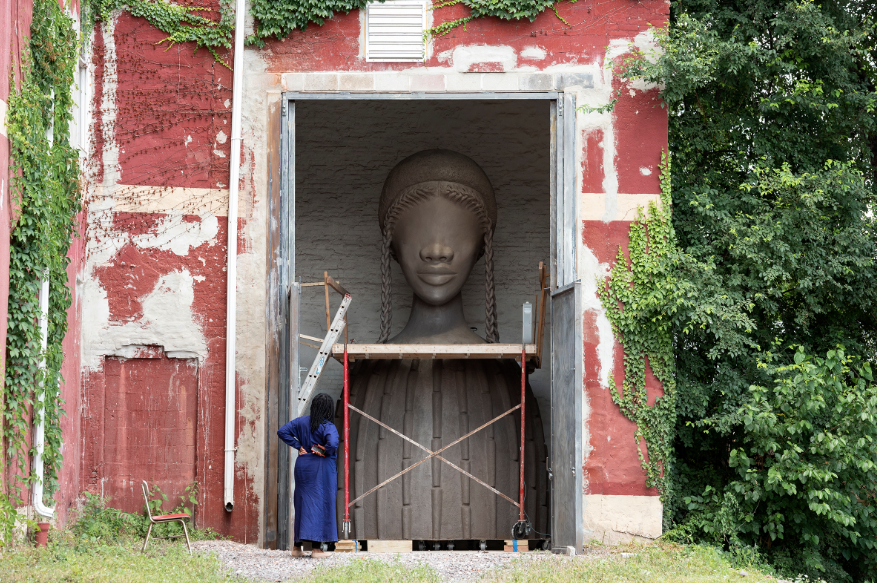The High Line’s Art-Centric Final Section Is Officially Open
Dubbed the Spur, the space will feature a rotating series of contemporary art commissions
/https://tf-cmsv2-smithsonianmag-media.s3.amazonaws.com/filer/0c/d7/0cd73bb7-b329-4641-8f14-bfaed4af9061/screen_shot_2019-06-06_at_32729_pm.png)
The Spur, a nearly mile-and-a-half long stretch of Manhattan’s High Line, opened to the public this week, marking the final stage in a 20-year campaign to bring the elevated outdoor walkway to life.
Situated at the intersection of 30th Street and 10th Avenue, the Spur—unlike the majority of the park, a more narrow, landscaped channel with limited pedestrian capacity that travels across several New York City neighborhoods—is designed for large-scale gatherings and creative contemplation. As CBS New York reports, this final section of the High Line transforms a set of abandoned elevated train tracks into a walkway and public space anchored by the Plinth, an annex marketed as one of the only sites in New York City “dedicated solely to a rotating series of new, monumental, contemporary art commissions.”
The Plinth’s first sculptural installation, Simone Leigh’s Brick House, is a 16-foot-tall bronze bust of a black woman whose skirt is reminiscent of a clay house. (Last August, the artist told The New York Times’ Robin Pogrebin and Hilarie Sheets that notions of such structures as primitive dwellings have long been “used to humiliate,” but in actuality, huts are “really quite beautiful and sophisticated objects.”) According to artnet News’ Sarah Cascone, the work serves as a “tribute to black feminine beauty and strength.” It was chosen from a shortlist of 12 artist proposals and will remain on view through September 2020, at which point a new commission will take its place.
Cast in bronze after an original model constructed from 9,000 pounds of clay, the figure’s head, according to the High Line’s website, is “crowned” with an afro surrounded by cowrie shell-adorned cornrow braids. The woman’s domed body, meanwhile, is decorated with a series of elongated ridges. Her gaze, Leigh explained to The New York Times’ last August, is pointed toward the sky in an expression of extreme pride.
A High Line blog post detailing Brick House’s creation notes that the sculpture—the latest installment in Leigh’s series on the “architectures of anatomy”—reflects architectural traditions of both West Africa and the American South. Among other influences, Taylor Dafoe writes in a separate artnet News piece, the work refers to the clay and wood structures popular among Togo’s Batammaliba people, the domed dwellings crafted by the Mousgoum people of Chad and Cameroon, and a Mississippi restaurant called Mammy’s Cupboard.
The last example offers the most direct visual comparison to the Plinth centerpiece. Built in 1940, Mammy's Cupboard features a 28-foot-tall sculpture of an archetypal “Mammy” figure. Although the sculpture was repainted in hopes of downplaying its racist overtones, its representation of a black domestic worker, in the words of the blog post, remains a “symbol for the labor she provides” and a “metaphor of body as function.”
Whereas Mammy’s Cupboard plays directly into stereotypical tropes surrounding black women, Brick House conveys a vision of powerful, assertive black femininity.
As the blog post explains, the name Batammaliba translates to “those who are the real architects of the earth.” Keenly aware of humans’ connection with their environment, the Batammaliba ensure that all of their buildings, from houses to places of worship and public spaces, are evocative of the body—a focus deftly reversed by Leigh’s Brick House.

“I wanted to express the kind of beauty that was about solidity and strength as opposed to fragility and weakness,” Leigh said during an opening ceremony held Tuesday.
“It’s an icon, it’s a goddess—this very powerful feminine presence in a very masculine environment, because all around you, you have these towering skyscrapers and cranes,” said Cecilia Alemani, director and chief curator of High Line Art, in an interview with Pogrebin and Sheets. “It’s very rare that in the public sphere you see a black person commemorated as a hero or simply elevated on a pedestal.”
The Spur represents the High Line’s widest open space, Jen Chung reports for Gothamist. Once threatened by development, the stretch of abandoned railway was rescued by a “Save Our Spur” campaign and officially acquired by the city in 2012. In addition to the Plinth contemporary art annex, the Spur boasts planted balconies, a passageway leading through luxury brand Coach’s global headquarters, and a collection of plantings comprising 8,500 perennials and 69 trees and shrubs.
As Rick Scofidio of architecture firm Diller Scofidio + Renfro, which designed the Spur alongside landscape architect James Corner and planting designer Piet Oudolf, concludes to artnet News, “It’s a place to view art, it’s a place to dance, it’s a place to listen to music, and it’s a place to be engaged by the neighborhood activities.”
/https://tf-cmsv2-smithsonianmag-media.s3.amazonaws.com/accounts/headshot/mellon.png)
/https://tf-cmsv2-smithsonianmag-media.s3.amazonaws.com/accounts/headshot/mellon.png)